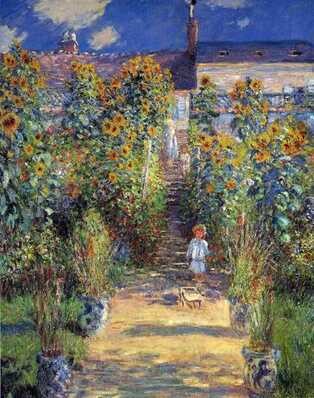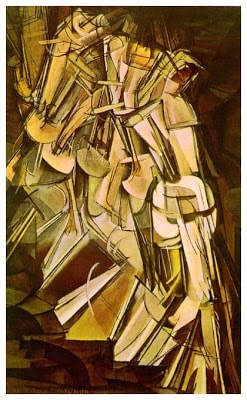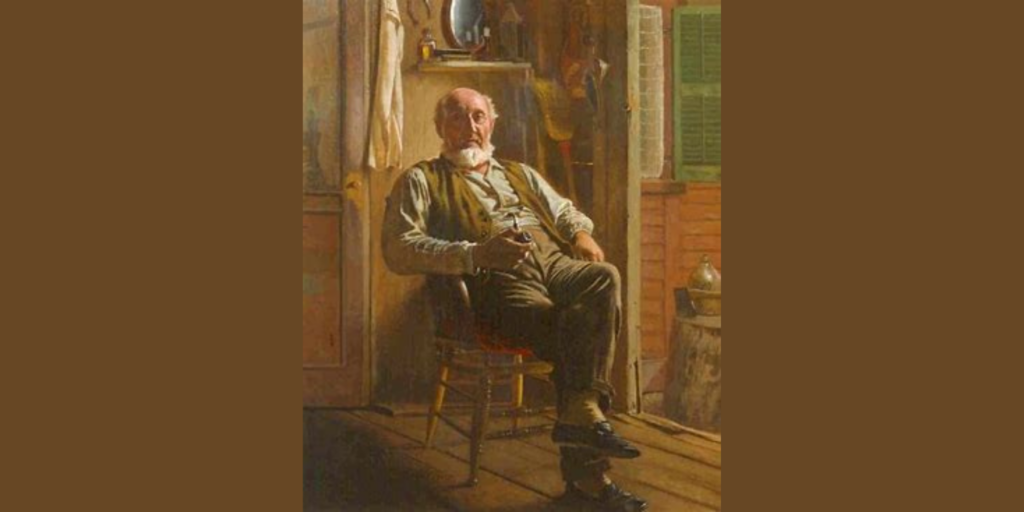Guest Blog by Gordon Sterling
Years ago, I was with the family visiting the Hunter Museum of Art in Chattanooga, TN. As I looked over the different styles of paintings, I realized there is a metaphor of the different styles of paintings and the different ways that we approach the study of God.
At the time of our visit there was a painting by John George Brown entitled, “Solid Comfort.” It was beautiful, and I found I could not pull myself away. I just stood there and soaked in all of the detail that he put into this painting.

It was a portrait of a little old man sitting in a chair holding a pipe. The wrinkles in his shirt and vest, how his left eye drooped a little bit, the detail in his beard, the slippers he wore — all of it was perfect. It made me want to get closer and examine each part to understand this little old man better.
And in doing so I was able to understand a little better the skill and patience of the artist and his incredible attention to detail. John George Brown was skilled, not just for replicating reality, but for gifting to the public a sense of
what he, the artist, was seeing. I was able to lay “me” aside and view the world of John George Brown. He wanted me to see things as he saw them.
Some critics say that John George Brown’s works are too bland and colorless. It’s too pedestrian, maybe a little dark. His works are so detailed that nothing is left to the viewer’s imagination or personal interpretation. Maybe the critics are right (after all they get paid to be critical), but I don’t think so. I want the detail because it speaks of the artist and his creativity.
Because ultimately, the painting is not about the critics, nor about me. The painting is about the artist and what he saw. And he lovingly shared that essence with us by his unmatched skill. It is so detailed that if you take the time to look, no one will have to explain the artist’s intent or what the painting represented. It’s there in front of you, for all those that will stop and examine it carefully.
This is how we are to approach learning about God. We should want to know every detail about this great God whom we call Father. And I think, well I know, He wants us to know Him. In fact, in Jeremiah, God said knowing Him pleased Him more than all the sacrifices. If we glory in anything let it be in this, that we understand and know Him. Not what touches our emotions or how we interpret who God is, but who God truly is.
In Romans 1:19-20 it says, “…since what may be known about God is plain to them, because God has made it plain to them. For since the creation of the world God’s invisible qualities—his eternal power and divine nature—have been clearly seen, being understood from what has been made…” Our Creator painted us the picture. We have to carefully examine it and if we do, if we put forth some effort, we will understand so much about the artist and His love for us, the patrons of the arts.
However, there are some people who prefer the impressionist painters. Those paintings are more colorful and just vague enough to allow the imagination to fill in some of the detail.
Claude Monet, for example, in his painting entitled, “The Artist’s Garden at Vetheuil,” illustrates this wonderfully. The painting is beautiful, the colors of the flowers, with two little children walking up the garden path. But there is no detail. The painting itself is perfunctory in that you don’t look at it for subject matter but merely the feeling of a summer day in a garden.

All of the detail you either ignore as irrelevant or you embrace emotionally as the colors hit your eye. But you do not know what the little girls look like. You can’t see their faces. Are they happy or sad? You don’t see the petals of the sunflowers. There seems to be a church or something in the background, but you really can’t make it out. Everything is up to the observer to develop as would please him.
It is a very sensual painting that you appreciate with your eyes as you see the colors, with your nose as you imagine the smell of the garden, and with your touch as you imagine feeling the breeze. And those things are why I truly love this painting.
However, the details are still missing. It is such that, on some level, I really can’t appreciate the skill of the artist because he does withhold that detail. The painting is not about the subject and really not about the artist. It is about me. What do I feel or think? How will I interpret this painting based on my senses?
Monet doesn’t want me to fully understand and know him. Can Monet really paint or is he simply good at mixing colors? Does he really understand the intricacies of nature and those little girls, or does he want me to make up my own reality? By looking at this painting, would I have faith in Monet to paint my wife’s portrait?
It is like when I hear a beautiful hymn or take communion or celebrate Easter. All of the emotions and the senses come alive as I worship. But those experiences must be supported by the truth of the artist Himself. In those moments, like the Monet painting, we are swept up in the childlike wonder of the beauty of who God is, but we must still seek to grow in our understanding of the truth of who God is.
Paul said in 1 Corinthians 13:11, “When I was a child, I talked like a child, I thought like a child, I reasoned like a child. When I became a man, I put the ways of childhood behind me.” There is a time and place for everything. We can enjoy the Creator like a child, but we are not to remain only in a childlike state. We must then thirst after His objective truth, to know and understand the Creator. In other words, we can enjoy the beauty of the painting but it must be grounded not in our feelings, but in the reality of our Creator God whom we call Father.

Some may prefer the style of cubism or cubo-futurism, like that of Marcel Duchamp. In his painting from circa 1912, “Nude Descending a Staircase,” there is no discernable detail. There is no discernable nude nor a discernable staircase. You do not see anything in particular, but I guess you can somehow detect the idea of movement or maybe interpret something descending.
If I were to compare this painting to John George Brown’s or even Monet’s painting, I would say that it gives me no information about Duchamp. But I would be wrong. This painting actually tells me a great deal about Duchamp and the people that would judge this painting as artistic genius and fork out good money for it.
Critics hailed this piece as “groundbreaking.” Art critics of the day loved it and told everyone
that they should love it too. If you did not understand the point of the painting and the “greatness” of the artist then you were a troglodyte, and artistically vapid.
But I look intently at this grey-brown assembly of geometric figures and don’t see a nude or a staircase, and, other than the fact that the image drifts from the top left corner to the bottom right, I can’t detect any descending. Is the artist a good artist? I don’t know, the experts say he is. The patrons say he is. The zeitgeist of the early 20th century imply that he is.
Is this an art cult where, “Dogma not anchored to a foundation of truth is a cult?” Is the truth so subjective that we move past any semblance of reality, such as Monet’s garden painting, into the bizarre and other worldly?
This cannot be an acceptable way to approach knowing and understanding God. This makes our own imaginings to be God and has thrown out any idea that there is an objective reality of God. We end up creating a God from our own feelings and imaginations.
Paul explained as much in his letter to the Romans. Romans 1:22-23 says, “Although they claimed to be wise, they became fools and exchanged the glory of the immortal God for images… (of cubes rolling from left to right).” These are the people that can easily be tossed to and fro by every wind of doctrine. They have no desire to know truth because truth is what is fashionable. What is truth in their imaginings today will be passé next week. They will profess themselves wise but alas are only fools.
About the Author: Gordon Sterling, Jr. is a brilliant teacher of the Bible. He is an amazing husband, Godly father, and loving Papa to two precious grandsons.




